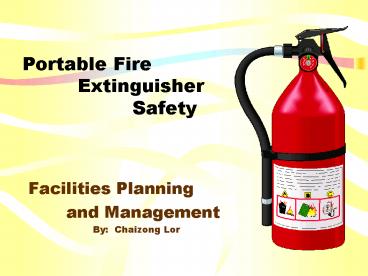Portable Fire Extinguisher Safety PowerPoint PPT Presentation
1 / 19
Title: Portable Fire Extinguisher Safety
1
Portable Fire Extinguisher
Safety
- Facilities Planning
- and Management
- By Chaizong Lor
2
Portable Fire Extinguisher Safety
- Training Objectives
- What is FIRE?
- The Fire Triangle
- Extinguishment Theory
- Types of portable fire extinguishers
- Major Causes of Fires
- Reporting a Fire Emergency
- Making the right decision
- Quick-Check
- How to use a portable fire extinguishers
3
Portable Fire Extinguisher Safety
- A rapid chemical reaction know as combustion
which occurs when fuel and oxygen are brought
together with sufficient heat to cause ignition.
4
The Fire Triangle
- Any combustible material such as solid, liquid,
or gas. Most solids and liquids must vaporize
before they will burn. - Sufficient oxygen must be present in the
atmosphere surrounding the fuel for fire to burn.
5
The Fire Triangle Cont.
- Sufficient heat energy must be
- applied to raise the fuel to its
- ignition temperature.
- Open flame Hot surfaces
- Sparks and arcs Friction
This reaction can occur when all three of the
above elements are present in the
proper conditions proportions.
6
Extinguishment Theory
- Three things must be present at the same time to
produce fire - Enough OXYGEN to sustain combustion
- Enough HEAT to reach ignition temperature
- Some FUEL or combustible material
- Together, they produce the CHEMICAL REACTION that
is fire - Take away any of these things and the fire will
be extinguished
7
Types of portable fire extinguishers
- Classification of Fire
- Class A or Ordinary Combustibles
- This includes fuels such as wood, paper, plastic,
rubber, and cloth
8
Types of portable fire extinguishers
- Classification of Fire Cont.
- Class B or Flammable and Combustible Liquids and
Gases - This includes all hydrocarbon and alcohol based
liquids and gases that will support combustion.
9
Types of portable fire extinguishers
- Classification of Fire Cont.
- Class C or Electrical
- This includes all fires involving Energized
electrical equipment
10
Types of portable fire extinguishers
- Classification of Fire Cont.
- Class D or Combustible Metals
- Examples of these types of metals are
- Zirconium
- Titanium
- Potassium
- Magnesium
11
Types of portable fire extinguishers
- Classification of Fire Cont.
- Class K for fires that involves combustible or
fats cooking oils in well insulated cooking
appliances in commercial kitchens.
12
Major Causes of Fires
- Carelessness with smoking and matches
- Misuse of electricity (overloading a circuit or
overuse of extension cords) - Improper rubbish disposal
- Improper storage of flammables (such as gasoline)
- Arson
13
Reporting a Fire Emergency
- Activate fire alarm on the way out of building.
- Notify Public Safety at 9-911. Give at least
- Your Name
- Your Location
- A description of the Emergency
- A description of current condition
- A description of any special hazards or needs,
such as hazardous materials storage or
non-ambulatory occupants - Stay on the line, unless told to do otherwise
14
Making That Right Decision
- You are trained in the use of extinguishers.
- You know what is burning.
- Fire is not spreading rapidly.
- Smoke and heat has not filled the area.
- You have a clear path of escape.
- Follow your instincts.
15
Quick-Check
- Is it Ready To Use?
16
How to use of Fire Extinguisher
- Use the P.A.S.S. Method
- It is easy to remember how to use a fire
extinguisher if you can remember the acronym
PASS, which stands for Pull, Aim, Squeeze, and
Sweep. - Pull the Pin.
- This will allow you to operate the extinguisher.
17
How to use of Fire Extinguisher
- Use the P.A.S.S. Method Cont.
- Aim at the base of the fire.
- Point the extinguisher nozzle (or hose) at the
base of the fire. - Squeeze the lever above the handle. This
discharges the extinguisher agent. Releasing the
lever will stop the discharge.
18
How to use of Fire Extinguisher
- Use the P.A.S.S. Method Cont.
- Sweep from side to side.
- Moving carefully toward the fire, keep the
extinguisher aimed at the base of the fire and
sweep back and forth until the flames appear to
be out. Watch the fire area. If the fire
re-ignites, repeat the process.
19
Any Questions
??
Please visit FPM Website
(www.uwec.edu/facmgt./index.htm)
for additional information.

